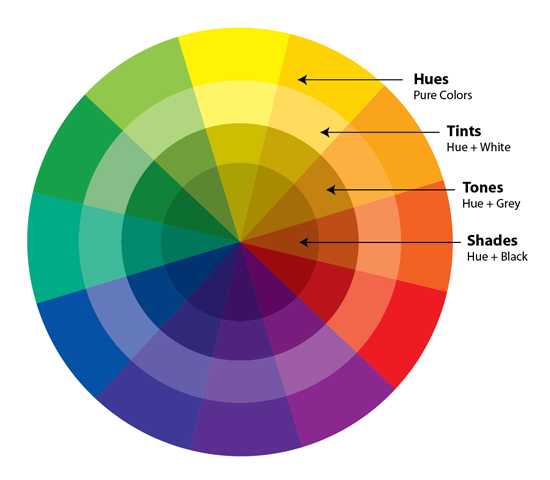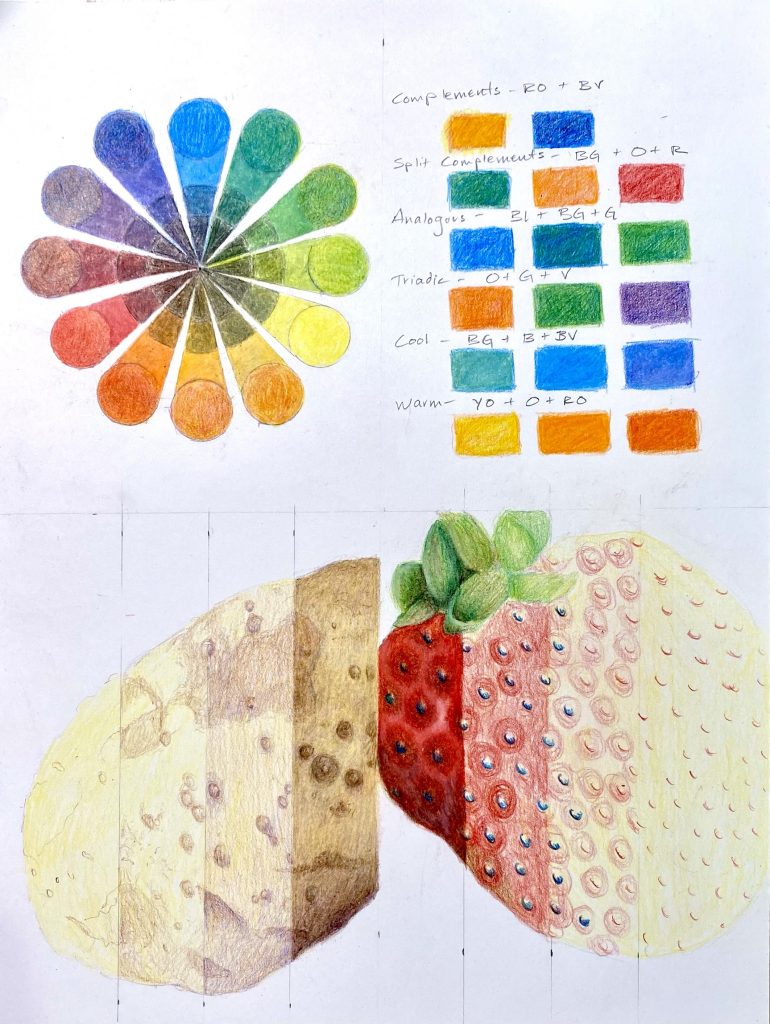
Learning Objectives:
- Students will be able to demonstrate appropriate colored pencil techniques through incredible craftsmanship.
- Students will be able to design engaging compositions using limited subject matter.
- Students will demonstrate appropriate color schemes when creating their drawings.
Materials:
- 2 sheets of Bristol or Illustration Board
- Prismacolor brand color pencils
- Pencil for sketching compositions
- Color photographs AND / OR real objects of each of the following:
- A Number
- A String
- A Strawberry
- A Target
- Three objects of your choosing (nothing with text and no electronics)
Sketchbook:
There are multiple parts to this project. In order for us to really understand color theory before we start the main project, there are a few smaller projects I want you to do as part of your sketchbook grade.
Part 1 – Take Notes in Sketchbook from the color theory section found here.
For parts 2 through 5 you will use one sheet of Bristol board divided into 4 equal parts. For the major project you will use one sheet of Bristol board cut in half.
Part 2 – For the second part of the project create a color wheel using your colored pencils. You will need to include primary, secondary and tertiary colors. The color wheel should include the hue, a tint, a shade, and a tone. Use the image below as a reference.

Part 3 – Create an example of each of the following color groupings – complementary, split complementary, analogous, triadic, cool and warm colors. Try to avoid red / green, blue / orange combinations.
Part 4 – Find a stick, rock or potato and bring it in. A lot of times the things that we think are just brown, beige or grey actually have a lot of color. I want you to bring that color out in this illustration. Don’t over emphasize colors that aren’t there but do pay close attention to the ones that are. Even grey sometimes has a hint of blue or red in it.
Part 5 – Using a colorful fruit or vegetable and Prismacolor, create a realistic drawing. Focus not only on proportions and shape but also on color. Is there a local color you can start with (like the red in a strawberry) and then build off of that? Even the red in a strawberry has hits of yellow and green. Try to build your layers slowly until you get the color color and texture.
It should look something like this when you’re done.

Project:
- In your sketchbook, work out several compositions using at least 3 of the elements from the list above (string, strawberry, etc). You must include at least 3 but do not need to use all of them. Your colored pencil drawings will be 5″ by 8″ so start with that size as you work out your compositions. Each of your compositions should be different from each other but you do not have to use different objects for each. Make sure I see these compositions before you start the next step.
- Using a sheet of 9″ by 12″ Bristol board and a pencil, draw a 5″ by 8″ rectangle in the center. Make sure it is centered – If done correctly you will have a 2 inch margin on all sides.
- Draw the compositions you created in your sketchbook to scale on your sheets of Bristol board. Use a very gentle hand when you’re drawing on your Bristol board. If you press too hard it will leave an indentation on the paper that will show up when you go to use colored pencils.
- Before you start using the colored pencils, work out color combinations in your sketchbook. Make sure you know the color scheme or theory your are going to work with before you start drawing. I will ask “What color scheme are you basing your drawing off of?” Be prepared to know. You do not need to stick to the actual colors of the object but be careful of using intense contrasting colors.
A hint – Colored pencils can be built up using thin layers to gradually create nice gradations, texture and shadows or applied more heavily for rich, intense colors. If the layer of wax from the colored pencil gets too thick, too quick it may be difficult to lighten it or erase it. Work slowly. Craftsmanship is of utmost importance. No pencil marks should show unless they are an integral part of the composition. One last note. Take care of your work. Fingerprints, smudges and creases will all affect your craftsmanship score.
Research:
Light and Color (Google Slides Presentation)











